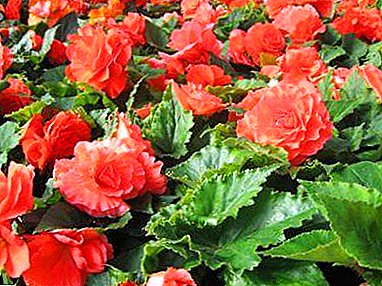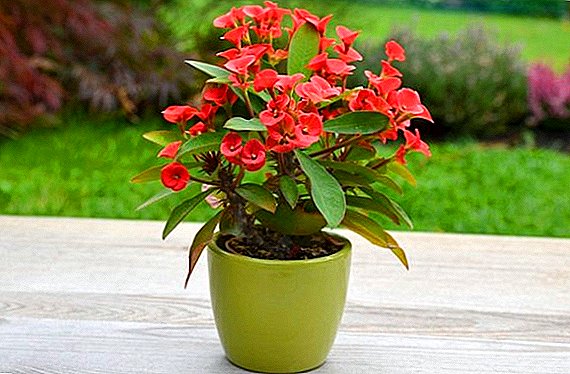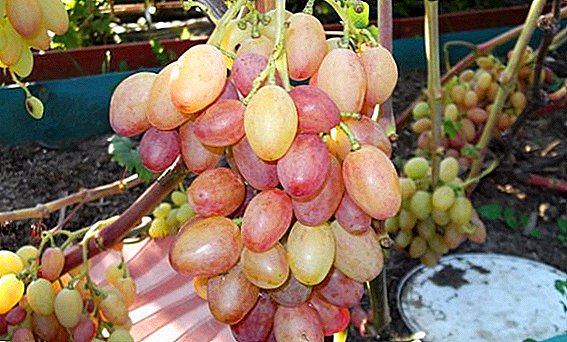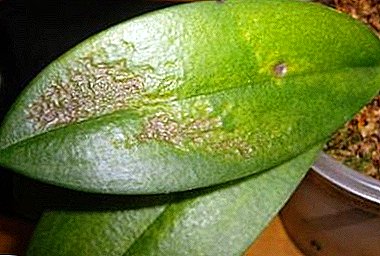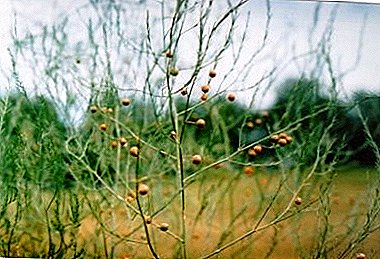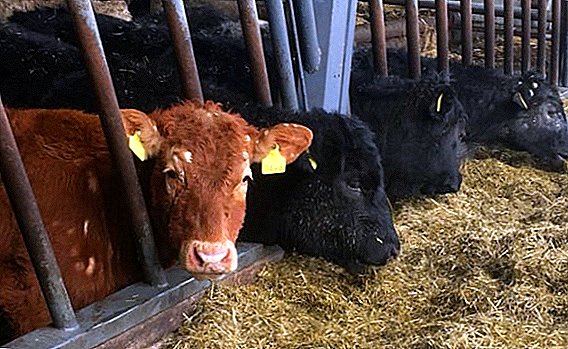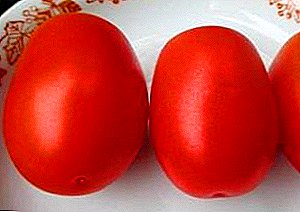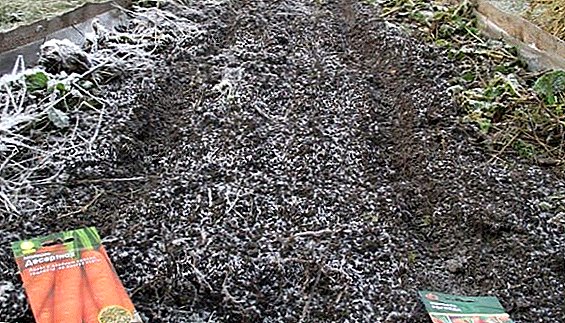 When planting carrots in standard terms (in spring) it turns out to harvest only by the beginning of autumn. However, there is another method by which you can enjoy homemade carrots in the middle of summer. It is about planting this root before winter. This method is not very popular and completely in vain. Planting carrots in the fall not only helps to get an early harvest, but also facilitates spring efforts on the site. On how to plant carrots competently in the fall and how to care for the sowing, we will tell further.
When planting carrots in standard terms (in spring) it turns out to harvest only by the beginning of autumn. However, there is another method by which you can enjoy homemade carrots in the middle of summer. It is about planting this root before winter. This method is not very popular and completely in vain. Planting carrots in the fall not only helps to get an early harvest, but also facilitates spring efforts on the site. On how to plant carrots competently in the fall and how to care for the sowing, we will tell further.
The best winter varieties
Picking the right grade is of paramount importance. Preference should be given to mid-season and early ripening varieties resistant to frost.
According to the experience of gardeners, the best varieties of carrots for the winter landing are such:
- Vitamin Great for fresh use in salads, appetizers. Fruits are bright orange, juicy, with a pronounced sweet taste. The variety is characterized by good keeping quality, does not crack, when planting is completely covered with a layer of earth, therefore there are no green or purple markings on the top of the root crops.
- Shantane Among the advantages of the variety: does not crack, shows high resistance to drought, perfectly preserved, has large fruits. However, the taste of the variety is somewhat worse than that of the vitamin. In addition, the fruit has a large core.
- Nantes. Very popular sredneranny grade of carrots for podzimny landing. Fruits are medium sized, cylindrical, with a small core and juicy orange flesh. Other advantages of a grade consist in good keeping quality and unpretentiousness.
- Losinoostrovskaya. The main advantages of the variety are high resistance to severe frosts. Fruits can be stored for a long time, without losing in taste and useful substances. They have a cylindrical shape, a small core, painted in bright orange, even a reddish color.
- Moscow winter. Unpretentious to the conditions of the mid-season variety of carrots. Well preserved, can be used for consumption in fresh, heat-treated and canned species.
- Beauty maiden. Medium early, color-resistant grade. It has high taste qualities: sweet, sugar, juicy and tender, the heart is small. The root crop is medium-sized, conical, has a bright orange shade.
- Our nanny. Versatile grade in use: suitable for fresh consumption, for preparing juices and canned food. Fruits are large, cylindrical or conical, with a small core, red-orange saturated color. Carrots of this variety are characterized by excellent sweet taste, juiciness and increased level of carotene.







Did you know? In medieval Germany there was a belief that the orange root crop was the favorite food of the dwarves. It was believed that if a bowl of carrots was taken to the forest for the night, in the morning you could find an ingot of gold with which the dwarves would pay back for the treat.
When to plant carrots in the fall
Determining planting dates is the second key condition for a good harvest. If you make a mistake with the planting date, the seeds will either come up earlier and will not survive the frost, or they will not be able to sow at all. Difficulties in determining the timing lie in the fact that in different regions climatic conditions differ, and the weather can be unpredictable and changeable. Because guided only by calendar recommendations will not work.
Crops that can be planted before winter are parsley, onion, garlic, potatoes.
Calendar dates and weather
Usually, seed producers indicate on packages recommended dates for sowing, including for sowing before winter. Depending on the variety, this period lasts from late October to early December. However, remember that during the autumn planting it is impossible to be guided by calendar dates - you need to be guided mainly by weather forecasts. 
Weather
It is necessary to choose a period when frosts occur, and frost follows immediately after them. To do this, you have to carefully monitor the weather forecasts. Ground temperature must sink to 2-3 ° С, but average temperature air must be in range 0-2 ° C.
Root crops should not be planted after precipitation, since seeds may begin to germinate in humid soil at a positive temperature. And if you still use the technique when planting (a large area of the site), then wet earthen clods will stick and clog devices, which will extremely complicate the process. After the rain you need to wait for the land to dry. It is quite acceptable if on the eve of landing a small amount of snow falls.
Did you know? Many people believe that orange is the natural and only color of the root, which is completely untrue. Initially, in the wild, the vegetable was purple in color, there were also roots of white, yellow, red and black shades. And the appearance of orange carrots occurred only in the XVII century in the Netherlands, thanks to the hard work of breeders.
Features of the region
The timing of the disembarkation of root crops will vary depending on the region and its climate:
- Moscow region. Landing is carried out from late October to mid-November.
- Siberia. In this harsh region, planting lasts from mid-October to mid-November. It is very important to choose suitable cold-resistant varieties.
- Ural Landing in the Urals takes place from late October to the first half of November.
- Ukraine. The farther south, the later should be landing. In the southern regions, it falls on the beginning and middle of December, in the northern part of the country - in the middle of November.

Where to plant on the site
When you have decided on the variety and the time is right, you should decide on the choice of site for planting.
Placing beds
Root grows well on sandy, loose soils with a neutral or slightly acidic level of Ph (5.5-7). It is important that good air exchange is maintained in the soil. Avoid areas with heavy, loamy or loamy soil. There should be a lot of light on the site, since its lack will lead to poor yields. It is also desirable that the land be flat or with a slight slope.
Important! You can not choose a place where a lot of melt water accumulates, otherwise the seeds rot.
Ancestors: good and bad
Orange Root Vegetable Shows excellent germination and yields in areas where such crops were previously grown:
- solanaceous (potato, tomato, eggplant);
- pumpkin (melon, squash, zucchini, watermelon, pumpkin);
- onions (onions, garlic, wild garlic);
- cabbage.
Especially good results will be, if the soil was fertilized with humus or compost under these crops.
Learn how to make compost with your own hands, in garbage bags, how to equip a compost pit.
You can not plant a root crop after beans and parsley, as there will be a high risk of damage to root crops by pests. Also, you can not plant an orange vegetable in the same place from year to year - you should take a break of 3-4 years.  Consider that after harvesting in the beginning of summer, you will have a decent area, which can also be occupied with something. Therefore, it is important to know what crops are recommended to plant after carrots. Allowed to plant cabbage, peppers, tomatoes. In general, the rule of crop rotation can be summarized as follows: it is desirable to alternate the roots with above-ground fruits.
Consider that after harvesting in the beginning of summer, you will have a decent area, which can also be occupied with something. Therefore, it is important to know what crops are recommended to plant after carrots. Allowed to plant cabbage, peppers, tomatoes. In general, the rule of crop rotation can be summarized as follows: it is desirable to alternate the roots with above-ground fruits.
Preparation of beds
To prepare the site for planting seeds need to be in advance when the temperature of the soil and air is still above zero.
Stages of preparation:
- Loosen the ground, crush breasts and lumps, level the area.
- Eliminate weeds.
- Make trenches up to 3-4 cm deep with a width of about 20-25 cm between them.
- Thoroughly tamp the ground in trenches, if the soil is "heavy", "fat" and clay, you need to lay a layer of sand up to 2-3 cm and once again properly rammed.
Important! In advance, you need to prepare the soil with which you will sprinkle the seeds. It should be pre-dried, break lumps, clean from debris and weeds. It is also worth first prepare the mulch.
At this, the preparation of beds ends and it remains to wait for the onset of frost for planting seeds.
Do I need preliminary preparation of seeds
In the classical planting of carrots in the spring, seeds must first be soak and germinateto increase germination. However, during the autumn planting of the root crop, these procedures are not recommended, since the seeds that have absorbed moisture can germinate prematurely and die from cold weather.
When choosing seeds, give preference to the freshest material that has been stored in proper conditions: when the air temperature is 14-16 ° C and humidity is not more than 75%. If the shelf life of seeds exceeds 3 years, such seed material should be discarded.
For autumn planting can not choose tape seeds, it should be traditional simple seeds.
The process, scheme and depth of sowing seeds
With the onset of frost you need to hurry with landing work:
- If snow falls, it should be carefully cleaned or swept away from the beds.
- Trenches can be a little sprinkled with ash to protect the crop from pests.
- Next, you need to scatter the seeds along the beds with a distance of 2.5 cm.
- Sprinkle about 2 cm in prepared soil.
- Top add a layer of peat or humus with a thickness of 2 cm.
- Soil need a little tamp.
- At the end of the beds can be sprinkled with snow, if it fell, or spruce branches.
It is important that the depth of the seeds is 3-4 cm. If the seeds are too close to the surface, they can be washed by melt water, and if they are too deep, the seedling process will be very protracted, since after the snow melts the seeds go deep.
Important! By winter, it is necessary to plant carrot seeds by 20-30% more than in spring, taking into account that some of the seeds will not rise.
Post-treatment care
In the spring, the shelter from the branches must be removed as soon as the snow melts. If the snow cover is too thick, it can also be slightly cleared to speed up the melting process. Next, over the area you need to stretch a dense fabric or film to a height of 20-30 cm to accelerate the shoots. When sprout appears, they, if necessary, need to thin out and weed.
We advise you to read about the cultivation of carrots (what to do if the carrots have not risen, how to properly water and fertilize, fight diseases); storage, benefits and harms, use in traditional medicine.
If the spring is too dry, young plants sometimes do not have enough moisture, because the unformed root system still cannot extract moisture from the deep layers of the soil. Because carrots, if necessary, moisten with warm water.
Carrots sown from autumn are not suitable for long-term storage, because you need to plant a root crop so that you use the crop for 1-2 months. Useful orange fruits will come at the right time at the beginning of summer, when the body needs vitamins so much. But early harvest can also be used for harvesting and processing. For many gardeners, podzimny planting vegetable seems troublesome and impractical, but in fact, this is a fairly quick process, which as a result brings a good harvest.



